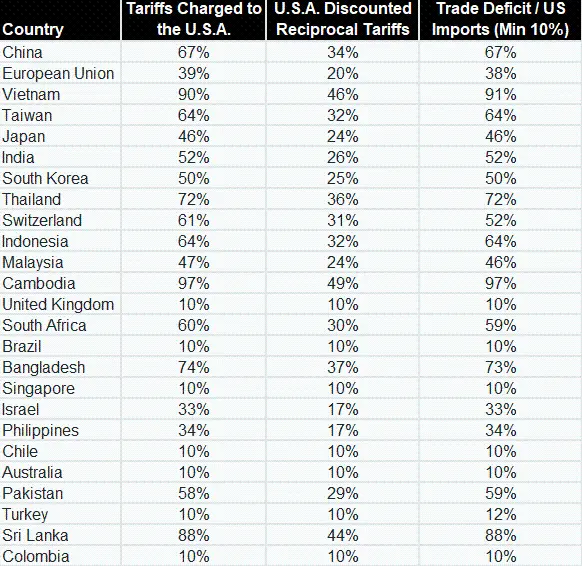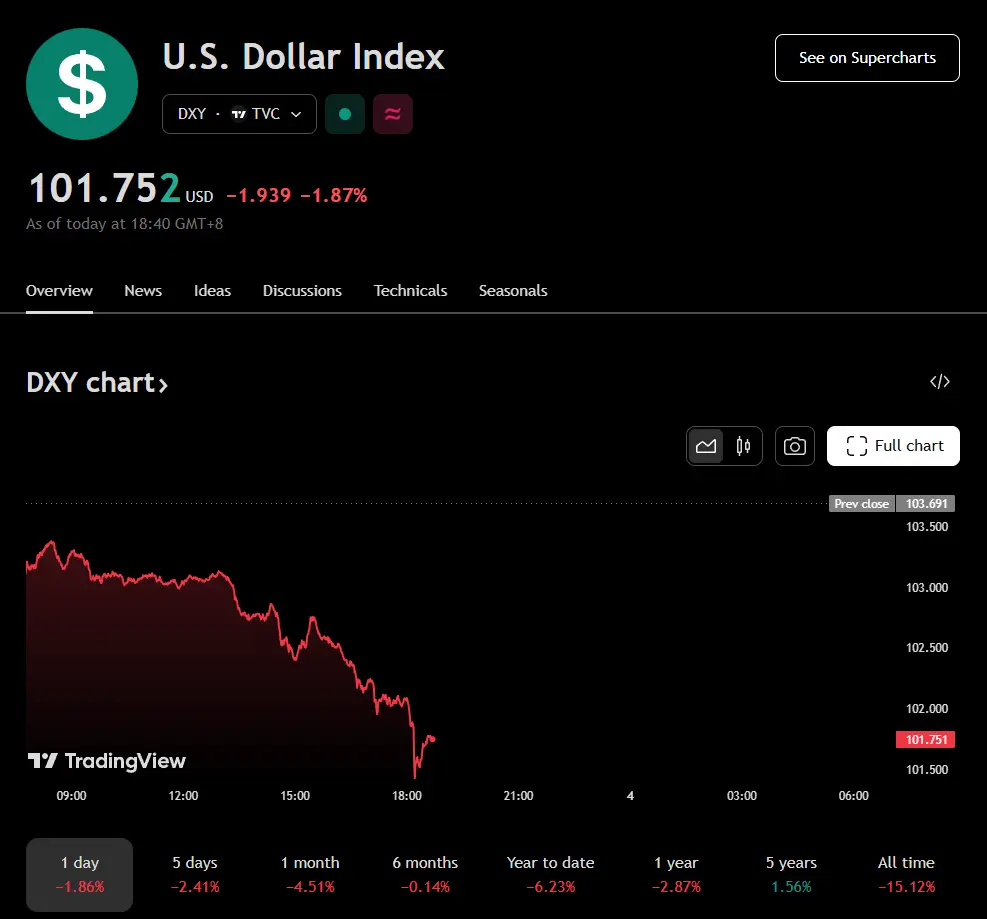Author: Luke, Mars Finance
In April 2025, the global financial markets were turned upside down overnight by Trump's "reciprocal tariffs" executive order. Bitcoin plummeted from a high of $88,000 to $82,500, while gold broke through $3,160 per ounce, setting a new historical high. Meanwhile, the US dollar index DXY fell below 102, hitting a new low since October of the previous year, and US stock index futures crashed, evaporating $2 trillion in market value within 15 minutes. The market expressed deep anxiety over the escalation of the trade war in the most direct price language.
In recent years, a strategy known as "left hand holding Nvidia and right hand holding Bitcoin" became popular in the investment circle—holding US tech giants with the left hand while chasing high-risk, high-return growth with Bitcoin in the right hand. However, investors have now shifted to "left hand buying Hong Kong stocks and right hand holding gold"—seeking undervalued and high-growth opportunities with Hong Kong stocks while holding gold as the preferred safe-haven asset. What has led to this shift from high risk to low risk, from a single market to diversified allocation? Let’s start with Trump's tariff policy and elaborate.
1. Trump's "Reciprocal Tariffs": A "Grassroots Performance"
On the evening of April 2, Trump signed two executive orders regarding "reciprocal tariffs" at the White House, announcing a 10% "minimum benchmark tariff" on 50 countries and regions worldwide, and imposing additional tariffs on about 60 countries with the largest trade imbalances, with rates as high as half of the tariffs they impose on US imports. This means that the effective tariff rate in the US could soar from 2.4% in 2024 to 25.1%, exceeding the levels seen after the implementation of the Smoot-Hawley Tariff Act of 1930. White House officials confidently stated that this would "revitalize American industry," bringing high-end industries like shipbuilding, aviation, and chips back to the US.
However, upon closer examination of the calculation method for these tariffs, we find a "grassroots performance." The formula used by the Trump administration is: MAX(10%, (import amount - export amount) / import amount). In translation, this means dividing the trade deficit by the import amount to get a ratio, then taking the maximum value between this ratio and 10% as the basis for tariffs on other countries. For example, the table shows that China imposes a 67% tariff on the US, while the US's "reciprocal tariff" is set at 34%, exactly half of what China imposes. This calculation method is so simplistic that it raises doubts about its seriousness—an Excel spreadsheet could produce it in 10 minutes, yet it is grandly termed "reciprocal tariffs."

Even more amusingly, Trump seems to know that this plan is too hardline, deliberately leaving a week as a "negotiation window." The benchmark tariff took effect on April 5, and the additional reciprocal tariffs on April 9, during which countries could negotiate with the US to lower tariffs. US Treasury Secretary Basant even publicly urged, "I advise all countries not to take retaliatory actions; we can talk!" This inevitably brings to mind haggling in a market: first shouting a high price, then waiting for the other party to bargain. Such a policy-making approach is far from the grand strategy of a major power; it is clearly a "grassroots performance."
However, the consequences of this performance are anything but funny. According to calculations by China International Capital Corporation, if these tariffs are fully implemented, US PCE inflation could rise by 1.9 percentage points, and real GDP growth could decline by 1.3 percentage points, falling into the risk of "stagflation." Economists at Morgan Stanley warned that Asian countries would be most vulnerable to the impact of tariffs, and policy uncertainty would dampen corporate confidence, further affecting capital expenditure and trade. The market's unease quickly transmitted, with Bitcoin rising and then falling, while gold became a safe haven for funds.
2. Bitcoin vs. Gold: The Battle of Roller Coasters and Safe Havens
On the night Trump's tariff policy was announced, the crypto market experienced a double whammy. As soon as the news broke, Bitcoin surged to $88,000, refreshing its high since March 25, with an increase of over 5%; but after the announcement of additional reciprocal tariffs, Bitcoin retraced its gains, falling below $82,500. In contrast, spot gold briefly broke through $3,160 per ounce, setting a new historical high. The performance of the two formed a stark contrast: Bitcoin showed no safe-haven attributes, while gold became the "stabilizing force" amid market turbulence.
The high volatility of Bitcoin is no secret. Data from Blockforce Capital shows that on March 24, Bitcoin's 30-day annualized volatility soared to 71.28%, reaching a nearly one-year high, while on February 23, this indicator was only 30.98%. This roller-coaster-like volatility precisely reflects Bitcoin's core attribute: it is highly dependent on global liquidity, with a correlation to liquidity as high as 83%. When market sentiment is optimistic and funds are abundant, Bitcoin can soar; but once liquidity tightens or uncertainty increases, it often bears the brunt. Trump's tariff policy undoubtedly exacerbated market concerns about liquidity, making Bitcoin's plunge understandable.

However, we cannot completely bearish on Bitcoin. BitMEX co-founder Arthur Hayes stated in a tweet today that if Bitcoin can hold the support level of $76,500 before the US tax day on April 15, "we will have escaped danger." He also reminded investors "not to be cut by the volatile market." From a technical perspective, there is significant selling pressure around $86,000-$87,000, but the spike to $88,500 last night has consumed some of that selling pressure, laying the groundwork for the next wave of increases. Bitcoin's retracement point may be between $93,000-$97,000, with the ultimate target at $100,000-$105,000. It is evident that despite the severe short-term volatility, Bitcoin still has room for growth.

Gold, on the other hand, exhibits a completely different logic. The World Gold Council proposed that gold returns can be approximated by a formula: Gold Returns = 3 × Global Nominal GDP Growth Rate - 1 × Growth Rate of Other Global Investment Markets. This formula explains 92% of gold's price changes through backtesting, showing that its core driving force lies in economic fundamentals and capital games. In the current context of heightened "stagflation" risk, gold's anti-inflation and safe-haven attributes are fully activated. In 2024, gold priced in US dollars rose by 27.2%, and since the beginning of 2025, it has continued to break through $3,160 per ounce, outperforming Bitcoin significantly.
3. The Fed's "Wait-and-See" and Market Chain Reactions
Trump's tariff policy not only impacted the crypto and gold markets but also put the Federal Reserve in a dilemma. On April 3, Fed Governor Adriana Kugler stated that maintaining the current interest rate level is appropriate until the risk of rising inflation subsides. She pointed out that the recent cooling of inflation has stalled, and long-term consumer inflation expectations have risen to a 32-year high, with policy changes potentially further raising inflation expectations. Although the impact of one-time tariffs on inflation is theoretically temporary, if it affects multiple sectors, the impact could be more lasting.
The Fed's "wait-and-see" attitude directly affected market liquidity. On April 3, the US dollar index DXY fell below 102, with a daily decline of 1.67%, hitting a new low since October of the previous year; the yields on US 10-year and 2-year Treasury futures fell by 10 basis points to 4.06% and 3.798%, respectively. The weakening dollar and declining Treasury yields reflect market concerns about economic slowdown, providing support for gold's rise.

At the same time, policy uncertainty has intensified market volatility. Some traders analyzed that the current market is pricing in the "worst-case scenario," with the sharp decline in US stock index futures and Bitcoin's rise and fall reflecting this process. However, they also believe that the uncertainty before April 5 may be the recent peak, and if countries make progress in negotiations with the US, market confidence is expected to recover. There are also warnings that if China takes retaliatory tariffs, a large-scale trade war may erupt, causing a double blow to inflation and the economy.
4. From "Left Hand Holding Nvidia and Right Hand Holding Bitcoin" to "Left Hand Buying Hong Kong Stocks and Right Hand Holding Gold": The Transformation of Investment Strategies
The popularity of the "left hand holding Nvidia and right hand holding Bitcoin" strategy is inseparable from the market environment of 2020-2021. It was a period of extremely high risk appetite: the Fed's low-interest-rate policy fueled a bull market in US stocks, with Nvidia's stock price soaring from around $100 in 2020 to over $300 in 2021 (after stock split adjustments); Bitcoin also broke through $60,000 in 2021. However, the fragility of this high-risk strategy was exposed in 2022. The Fed's interest rate hikes, global economic slowdown, and geopolitical risks led to a sharp decline in both the US stock and crypto markets.
In 2025, Trump's tariff policy further exacerbated market uncertainty, prompting investors to shift to the "left hand buying Hong Kong stocks and right hand holding gold" strategy:
- Left hand Hong Kong stocks: The Hong Kong stock market is undervalued (the Hang Seng Index's price-to-earnings ratio has long been below 10 times) and benefits from the recovery of the Chinese economy and policy support. At the beginning of 2025, the Chinese government launched a series of measures to stimulate the economy, making Hong Kong stocks a popular choice for capital inflow.
- Right hand gold: Gold, as a traditional safe-haven asset, is favored in the context of heightened "stagflation" risks. In 2025, concerns about global economic slowdown and geopolitical tensions pushed gold prices to break through $3,160 per ounce.
The shift from "left hand holding Nvidia and right hand holding Bitcoin" to "left hand buying Hong Kong stocks and right hand holding gold" essentially reflects investors' transition from chasing high growth to seeking safety and diversification. Traders predict that if the tariff policy is implemented as currently stated, Bitcoin's peak this week may be around $88,500, and liquidity will remain tight during the upcoming US tax season, with expected rebound peaks at $90,000-$91,000. Meanwhile, gold may continue to benefit from safe-haven demand, maintaining its upward momentum.
5. Market Outlook for 2025: Opportunities Amid Uncertainty
Trump's "reciprocal tariffs" policy has pushed the global trade system into a new round of competition and triggered a chain reaction in the financial markets. In the short term, policy uncertainty may continue to dampen market confidence, and high-risk assets like Bitcoin will face liquidity pressures. However, from a technical perspective, Bitcoin still has room for growth; if it can hold the support level of $76,500, it may challenge the $100,000 mark in the future. Gold, on the other hand, has greater advantages under "stagflation" risks and is expected to continue setting new highs in 2025.
For investors, 2025 will require greater attention to the competition between major asset classes. The combination of Hong Kong stocks and gold may be a wise choice to cope with uncertainty. As the old saying goes, "In any market environment, there is always an asset in a bull market." Let us wait and see how the market unfolds in 2025.
免责声明:本文章仅代表作者个人观点,不代表本平台的立场和观点。本文章仅供信息分享,不构成对任何人的任何投资建议。用户与作者之间的任何争议,与本平台无关。如网页中刊载的文章或图片涉及侵权,请提供相关的权利证明和身份证明发送邮件到support@aicoin.com,本平台相关工作人员将会进行核查。




